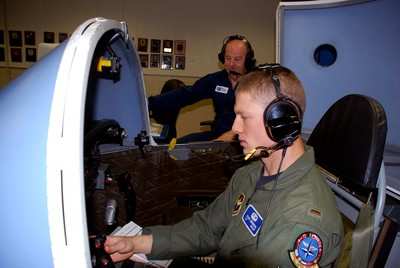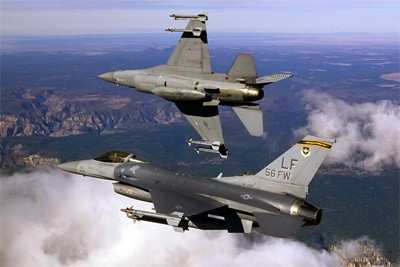Goal Is Most Efficient Use Of Resources For Ongoing
Training
 Headquarters Air Force Director of Operations personnel plan
to work closely with those in the Air Force Agency for Modeling and
Simulation and the MAJCOMs to define the right balance of live
flight hours and Distributed Mission Operations-Live, Virtual and
Constructive, or DMO-LVC, to train warfighters.
Headquarters Air Force Director of Operations personnel plan
to work closely with those in the Air Force Agency for Modeling and
Simulation and the MAJCOMs to define the right balance of live
flight hours and Distributed Mission Operations-Live, Virtual and
Constructive, or DMO-LVC, to train warfighters.
DMO is the term for linking personnel at different locations in
simulated operations. The elements of LVC are real people training
on their operational equipment (live), real people training using
simulators (virtual), and models and simulations of people and
equipment (constructive).
During his first visit to AFAMS Feb. 25, Maj. Gen. Brett T.
Williams, director of operations in the office of the deputy chief
of staff for operations, plans and requirements at Headquarters Air
Force, said he is focused on getting the best use of the limited
resources to attain the highest possible level of readiness across
the spectrum of Air Force operations. "Looking across the spectrum
of combat air forces, mobility air forces, space and cyber, what is
the optimum mix of live activity and DMO-LVC if you have no funding
or technical constraints?" General Williams asked. According
to the general, the answer to that question lies in balancing
effective training and cost efficiency.

USAF T-37 Flight Simulator
Modeling and Simulation, or M&S, isn't a wise return on
investment if the simulations do not accurately reflect real world
capabilities to the extent that it's just like operating the actual
combat system, he said. Live operations are not always an option,
and some capabilities only can be performed safely in simulation.
Security and latency are also issues that must be satisfied. "The
secret sauce is in the connectivity and networking required for
DMO-LVC," General Williams said. "The technical challenges
are significant, but there are policy and governance aspects,
especially involving multiple classification levels, that are just
as formidable."
Officials at AFAMS, an Air Force field operating agency, have
been working with MAJCOMs and sister services on an initiative for
an Enterprise Architecture-Live Virtual and Constructive
Environment, or EA LVCE, to maximize LVC assets by focusing on
M&S that integrates with Air Force, joint and coalition systems
in exercises. This would allow LVC elements to be integrated for
exercises and training. "AFAMS is the Air Force integrator of
M&S policy, capabilities and resources," said Col. Marcus A.
Boyd, AFAMS commander. "It is the execution arm of Air Force
M&S. We have much of the collective expertise and contacts
throughout the joint LVC communities."

The intent of EA-LVCE is not to take M&S programs from
commands or sister services, Colonel Boyd said. "We just want to
leverage the programs," he said. "Build whatever you want, but when
it plugs in, we want to define the interface so it can plug into
joint LVC environments."
General Williams also pointed out that part of the equation is
an appreciation for risk and readiness. "Today we cannot satisfy
all of our live training requirements, nor can we deliver all of
our DMO-LVC needs," he said. "Some of the shortfalls require
technical advances and some will be addressed through more
efficient use of our resources. AFAMS has a key role in both of
these areas.
"We must bring all the pieces together first," he continued. "We
need an integrated process. It's about mission risk in the end. If
we're going to increasingly rely on M&S ... then AFAMS needs to
be called in early in the process to gather and assess
requirements, offer solutions and serve as the integration engine
between the technical community and the operators."
As the Headquarters Air Force A3O, General Williams is
responsible for policy and oversight of Air Force operations. The
secretary of the Air Force and the chief of staff of the Air Force
directed the transfer of AFAMS from the Secretary of the Air Force
A6 to Headquarters Air Force A3/5.
 SpaceX to Launch Inversion RAY Reentry Vehicle in Fall
SpaceX to Launch Inversion RAY Reentry Vehicle in Fall Aero-News: Quote of the Day (04.23.24)
Aero-News: Quote of the Day (04.23.24) Aero-News: Quote of the Day (04.20.24)
Aero-News: Quote of the Day (04.20.24) ANN's Daily Aero-Linx (04.20.24)
ANN's Daily Aero-Linx (04.20.24) Aero-News: Quote of the Day (04.21.24)
Aero-News: Quote of the Day (04.21.24)





